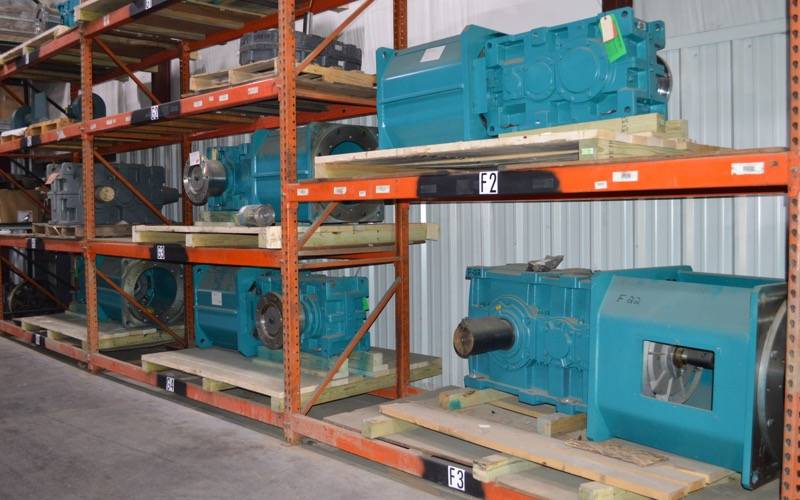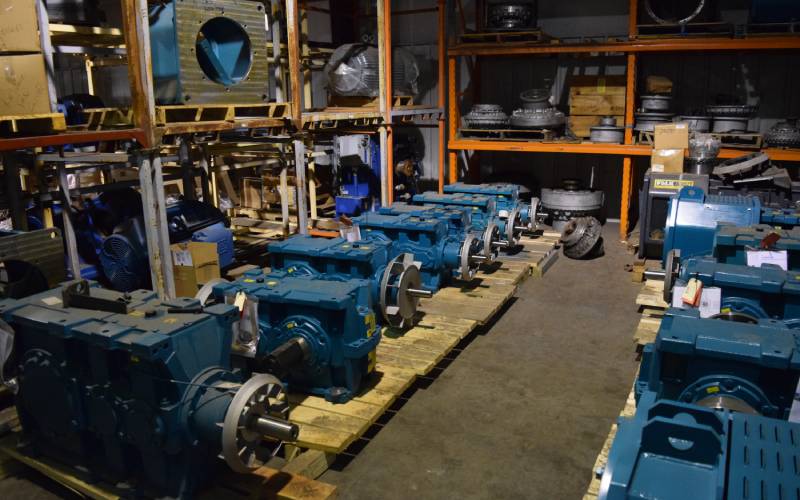Choosing the Right Reducer/Gearbox Parts for Your Conveyor

Reducer gearings or gearboxes are the unsung heroes of conveyor operations, turning raw engine power into the right combination of speed and torque to keep your belt rolling day in and day out.
In this article, we take a closer look at choosing the right speed reducer gearbox for your conveyor and conveying operation. More specifically, we’ll explore what reducer gearings do and the factors that affect their efficient operation.Â
We also examine several considerations to keep in mind as you go about choosing the right parts for your conveyor belt installation, including the importance of working with a reputable and knowledgeable parts supplier. Read on to learn more!
ROLL RIGHT: HOW TO CHOOSE THE RIGHT GEARBOX FOR A CONVEYOR
Whether your conveyor is working to transport sand, gravel, coal, ores, or refined products, you must rely on it to work effectively. Numerous moving parts enable your conveyor to perform reliably and efficiently, transporting product over considerable distances, but your reducer/gearbox drivetrain is among the most important.
GEARBOXES: THE HEART OF YOUR CONVEYOR
It’s said that the gearbox is the heart of the conveyor. If it’s working well, the conveyor will too. But if it’s not, that’s going to translate to downtime, repair costs, and lost productivity, which can eat into profit margins.
The main role of reducer gearing is to adjust the power transmission of your diesel or electric motor to speed or slow down the conveyor belt.Â
It does so by controlling the amount of torque that is delivered. This reduces stress on the motor and other moving parts and helps belts work better for longer.
As a result, choosing the right reducer gearing for your conveyor and operating conditions is a critical decision.Â
CHOOSING A GEAR REDUCER: FACTORS TO CONSIDER
Let’s start by considering the types of operating demands that your conveyor will need to meet. These include:
- The average and peak speeds and torques your conveyor will need.
- How many hours per day will your conveyor run?
- The types of load your conveyor will carry, including ores, aggregates, sands, or processed products.
- The type of terrain your conveyor will cover. Steep terrain greatly increases the need for high torque equipment and high reduction ratios.
- The environmental conditions that your conveyor will operate in. Will it be exposed to excessive heat or cold?Â
- Exposure to excessive impact shock or vibration
Different types of reducers and gearings will suit different applications and operating conditions. It’s worth working with an experienced supplier like West River Conveyors to ensure you are choosing the right equipment for your setup.
TECHNICAL CONSIDERATIONS
Now let’s break down some technical considerations you’ll want to keep in mind when selecting a reducer gearing for your conveyor or other associated parts like seals, wiring, and vent plugs.
REDUCER/GEARBOX TYPES
Whether you are building new or refurbishing an existing conveyor, it’s important to understand how different gearboxes affect their operating characteristics. Popular types of gearbox designs include:
- Bevel gears
- Concentric
- Helical
- Right/90-degree angle
- Parallel
- Worm gears
- Inline
- Planetary gearbox
- Shaft
- Vertical
Different gear configurations deliver different combinations of gear and torque. Some may be more compact, making them better suited for applications where space is at a minimum.Â
SIZE TO THE LOAD
Many engineers make the mistake of sizing the gearbox to the type of motor rather than the load the conveyor is working with. This usually results in the purchase of a bigger gearbox that is too much for the load, resulting in wasted energy, and increased maintenance and repair bills.Â
Instead, you should be sure to size the gearbox to both the maximum and average load demands, including often extreme startup demands. While this may be harder to calculate than raw motor power, it will result in better torque multiplication and speed requirements, ultimately saving you money on energy usage and conveyor downtime.

OTHER CONSIDERATIONS
The efficiency and effectiveness of your reducer gearings also depend on factors beyond your equipment itself.Â
ENVIRONMENTAL FACTORS
Conveyors do not operate in a vacuum. Factors like ambient temperature, dust, and corrosion affect not only what type of reducer gearings your conveyor will need, but also how efficiently they can run. Harsh environments might require special equipment or more robust gearing designs to deliver optimum performance.
For example, high temperatures increase the internal pressure on gearing, meaning there could be an increase in service factor overload capacity.
LOAD TYPES
Loading factors go beyond the average weight on the line. Different materials have unique troughing characteristics, affecting load distribution. Some applications experience increased impact shock when the material is dumped, testing the limits of your gearings. Uneven loads and vibrations also reduce gearbox efficiency.Â
TERRAIN
Big elevation changes will put far greater strain on your reducer/gearing assemblies, but flat terrain or gradual slopes bring their own torque vs. speed challenges. How much line will each gearbox need to serve?Â
SPACE
Is your conveyor running in a confined space (e.g. underground) or is space not an issue? If space is a challenge, then selecting a compact reducer should be considered. For example, shaft mount reducers are known for being space-saving compared to other types.
MAINTENANCE
Maintenance should always be a key consideration when weighing reducer options. Unexpected repair only leads to downtime and lost productivity, which will always weigh on your bottom line. Proper preventative maintenance is key to keeping anything working efficiently and effectively.
Selecting a reducer gearing that’s a good fit, easy to install, and easy to maintain is imperative to keep downtime and repair costs to a minimum.
MATERIAL
Reducer gearboxes come in aluminum and cast iron among other metals. When choosing the right material for your equipment it’s essential to understand the operating characteristics of each material and how they match specific environments.
For example, cast iron is very strong but liable to chipping and cracking under strain. Aluminum lacks the strength of cast iron but is more flexible and less susceptible to corrosion. A seasoned equipment provider like West River Conveyors can advise you on the best materials for your application and operating conditions.
BRAND
There are many reducer gearing brands available, such as Dodge, Falk, Foote Jones, Hansen, Rexnord, and Browning, to name a few. Is there a brand that you’ve had a good experience with?Â
Brand quality is more important than low price. This is where a trustworthy supplier comes in handy, as they can help recommend a reducer gearing manufacturer ideal for your requirements.
SELECTING THE RIGHT REDUCER/GEARBOX GEARING PARTS
The components that you integrate into your conveyor — including reducer gearings — shouldn’t be an afterthought, but a priority. The right equipment will improve productivity, reduce energy use, and minimize maintenance costs. A poorly matched gearing will cost you far more in excessive wear and energy use and expensive unplanned downtime.
It’s worth taking the time to work with an experienced equipment supplier to ensure you get the best match for critical equipment like reducer gearboxes. West River Conveyors is a leading provider of high-performance conveyor systems and parts. We have almost 40 years of experience providing quality parts for the most demanding material handling applications.
Let us know about your gearing reducer challenges. We’ll be happy to recommend and source the right equipment for your operation that combines quality, reliability, and affordability. Contact us today, or click below to learn more about our reducer gearing offerings.
See In-Stock Reducer/Gearbox Parts
Wood chips blades are key components used in wood chippers. Chipper knife main function is to cut large wood materials such as wood and branches into small pieces or wood chips for further processing or utilization. The following is a detailed introduction to wood chippers:
Material of wood chipper blades
1. High Carbon Steel
Advantages: high hardness and good wear resistance.
Disadvantages: easy to rust and need frequent maintenance.
2. Alloy Steel
Advantages: better wear resistance and toughness, long service life.
Disadvantages: high cost.
3. Carbide
Advantages: extremely high hardness and wear resistance, suitable for high-intensity cutting.
Disadvantages: brittle and easy to break.
Application areas of wood chippers
1. Garden maintenance
Used to process garden waste, such as branches, leaves, etc., to make compost or mulch.
2. Wood processing
Process wood into wood chips for the production of pulp, particleboard, etc.
3. Agricultural waste treatment
Treat crop waste, such as corn stalks, cotton stalks, etc., to make biomass fuel or organic fertilizer.
Chipper Knife,Chipper Blades,Chipper Blade,Wood Chips Knife
HuataoGroup , https://www.industrial-knives.cn